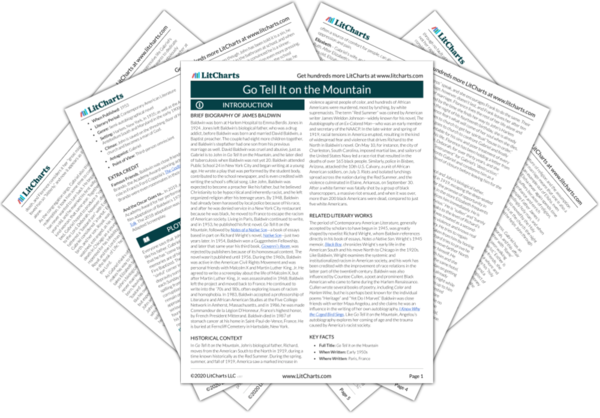James Baldwin’s Go Tell It on the Mountain is set in Harlem in 1935, some twenty years into America’s Great Migration. After the Civil War and the end of slavery in 1865, the country entered the Reconstruction Era, in which African Americans were finally afforded freedom and equality under the constitution. In practice, though, people of color continued to be treated with widespread discrimination, exploitation, and abuse, especially in the South—thus began the Great Migration, or the mass exodus of African Americans from the South to the North. While the bulk of Baldwin’s novel takes place in 1935, he examines race and racism in the Antebellum South, through Reconstruction, and finally North with the Great Migration, and he explores how slavery affects people of color from generation to generation. Through this exploration of race and racism in America, Baldwin argues that while slavery may be a thing of the past, its consequences have resonated far into the future.
Gabriel tells the story of his mother, Rachel, who was a slave for over thirty years in the American South. Rachel, who was born on a plantation, saw many “tribulations” throughout her life, most notably “death, and parting, and the lash.” Rachel and the other slaves were forced to endure savage beatings and even murder simply because they were black and deemed inferior to their white “masters.” Rachel was made to rise “in the morning before the sun came up” and work all day in the fields, only to be fed “bits of ham and chicken and cake left over by the white folks.” Rachel toiled all day long making money for her master and was given left over kitchen scraps like a dog. Before slavery was abolished, Rachel had four children, “all of whom had been taken from her, one by sickness and two by auction; and one, whom she had not been allowed to call her own, had been raised in the master’s house.” Not only was Rachel made to endure the selling of her children into slavery, she was also raped by her master and then denied the child produced by that rape, as the child was considered white and not black. Rachel had to bear unimaginable suffering because of slavery and racism, and as Go Tell It on the Mountain goes on to show, this suffering did not end simply because slavery was later abolished.
The deep-seated racism produced by American slavery even plagues Rachel’s children who are born after the Civil War, which is reflected most clearly in Rachel’s daughter, Florence. Florence despises her younger brother, Gabriel, and cries, “I hate him! I hate him! Big, black, prancing tomcat of a [n_____]!” Deborah, Florence’s closest friend and Gabriel’s future wife, reminds Florence that “the Word tell us to hate the sin but not the sinner.” With this, Deborah implies that Gabriel’s blackness is a sin, and her opinion reflects how deeply racism affects Americans, as it is even internalized by black people themselves. Later in life, Florence bleaches her skin because she assumes that Frank, her husband, doesn’t “want a coal-black woman.” Frank believes that “black is a mighty pretty color,” but Florence disagrees. Florence’s opinion also reflects the racist assumptions of Reconstruction Era America, and because of this, she doesn’t believe that she can be both black and beautiful. Likewise, Florence frequently refers to black men as “common [n_____s],” the “lowest of low,” who “drink cheap moonshine, and play music all night long” and “do worse things” that “are far better left unsaid”—in other words, she equates blackness with criminality and depravity, and this, too, reflects the racist stereotypes of early twentieth-century America.
Gabriel’s son, John, must endure racism in the North in 1935 as well. Segregation has relegated John to “the back door, and the dark stairs, and the kitchen or basement,” yet the ugliness of racism in America is most apparent in the story of Richard, John’s biological father. Richard moved North in 1919, and he quickly discovered that while the North “promised” more to African Americans, “what it promised it did not give, and what it gave, at length and grudgingly with one hand, it took back with the other.” Richard was falsely accused, arrested, and tried for “robbing a white man’s store” simply because he was black and in the wrong place at the wrong time. Although he was eventually found innocent, Richard committed suicide immediately after his release from jail, the racism of “the white city, the white world” too heavy a burden. It is through this tragic and multigenerational look at racism in America that Baldwin implies slavery, while technically over, has produced a legacy of racism and pain that has not lessened with time and continues to affect black people across America.
Race and Racism ThemeTracker








